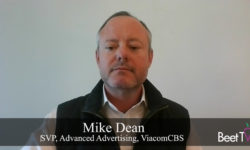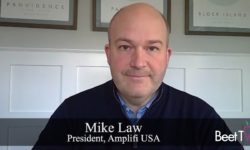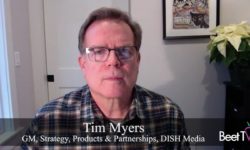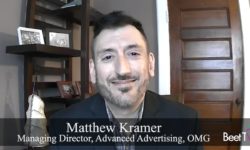If fragmentation was the price of scale, would you take it or leave it? That’s the question many buyers of over-the-top (OTT) TV ads have been asking themselves.
But, as more opportunities are lit up to deliver targeted ads across the entire US, some are swallowing the challenges – whilst hoping for a more straightforward 2021.
In this video interview with Beet.TV, Samantha Rose, Horizon Media SVP, Advanced TV & Video Solutions, says OTT has come a long way – and, yet, has a way to go.
National excitement
“I think OTT at this point is table stakes,” Rose says. “As consumption is shifting out of the linear space and into the non-linear space, OTT is where we know a lot of those eyeballs are headed. That was really incorporated into our media buys several years ago.”
Until now, it has mostly been offered by local cable operators, but growing capabilities from national operators are expanding the opportunity.
“National enablement really is going to increase the scale of the addressable marketplace very considerably,” Rose says. “It’s making the inventory on that other 14 minutes of inventory, of commercial inventory on national TV networks, addressably enabled.
“That’s going to make it a much larger landscape. It’s really exciting because it combines the scale and opportunity of national TV with the targetability that addressable has offered the past several years.”
Fragmented landscape
That comes with its challenges, however. The more that agencies and brands lean into national-level addressable, as it rolls out, the more they have to struggle with a splintered market.
The problem, as Rose puts it, is having to buy in separate chunks – “a few million TV sets over here, a few million households over here”.
“Trying to bring that together and deliver back a media buy, a holistic media buy to a client, is much more challenging than when we were just buying linear across the total TV landscape,” she says.
Growth through simplicity
In November, eMarketer forecast connected TV ad spending will grow 40.1% in 2021, but less in later years, reaching $18.29 billion by 2021.
To boost growth, most people in the industry pine for simplification. So Rose is hoping for things to coalesce.
“It’s not completely standard yet,” she says. “It’s much more difficult and challenging to move forward from the advertiser’s perspective.
“There’s a lot of different vendors and a lot of different publishers in the mix. What we really need is standardisation, and really trying to wade through that and understand how to transact in that marketplace, it still remains to be seen.
“Standardisation is key. Collaboration is going to be what’s going to make it move forward.”
Closing the loop
As TV becomes connected, it becomes trackable, measurable in a way that traditional panels – premised on merely age and gender demographics – could not accommodate.
Closing the loop between TV ad exposure and viewers’ consequential actions could transform TV into a performance ad channel.
“Business outcome results and business outcome guarantees is something that’s absolutely a top of mind for us at Horizon,” Rose says. “We would love to be able to connect, not just guaranteeing that the audience are seeing our advertising, but that it’s actually delivering sales lift, location visits, brand health lifts, things like that.”
Addressable TV Can Overcome Challenges: Horizon Next’s Wallach-Baker
Rose says 2021 is likely to see a big solidification in such campaigns, after a 2020 when “outcomes” was high on the discussion agenda with clients.
“We had a lot of those business outcomes discussions in the works on behalf of our clients and with our partners, and unfortunately with everything else with 2020, that sort of paused because of everything that happened,” she says.
“2021 will be a good year to get back on track. For business outcome results, I could see that being huge.”
You are watching “An Open Ecosystem is Key to Advanced TV Success,” a Beet.TV leadership video series presented by DISH Media. For more videos, please visit this page.



































